The synagogues in Izmir basically express regional characteristics. People enter the main area of prayer through the Midrash and the Ehal has a triple structure. On both sides of the Ehal (bookcase of holy books) which is situated in the middle of the Eastern Wall, there are built-in-closets made in the same style, and they all contain holy books.
Another characteristic of the synagogues in Izmir is that they were built in central plan. The Teva (stand) is situated in the center of four columns which support the ceiling of the synagogue, and divides the ceiling and the synagogue into 9 sections. In later periods, the central plan was changed with double Teva structure which was placed in the sides of the Ehal.
SYNAGOGUES ALREADY AVAILABLE IN IZMIR:
Shalom, Sinyora Giveret, Algaze, Bikur Holim, Etz Hayım, Talmud Tora, Hevra, Los Foresteros, Portekiz are located around Kemeralti. Beit İsrail ve Rosh Ha-Har at Karatas, Saar Asamayim at Alsancak and Ahavat Shalom at Karsiyaka.
CONTACT EBRULITUR TO VISIT THE SYNAGOGUES IN IZMIR
Visiting the historical synanogues is subject to permisson by the Jewish Community Foundation of Izmir. Ebruli Tourism is responsible for the procedure. Anyone who wants to visit the synagogues will have to get intouch with us. We shall forward your request to the Jewish Community Foundation to obtain permission.
Contact:
E- mail: ebrulitur@ebruliturizm.com.tr
WhatsApp: 90 (549) 717 17 40
Telephone: 90 (232) 463 60 43 – 90 (232) 464 07 18
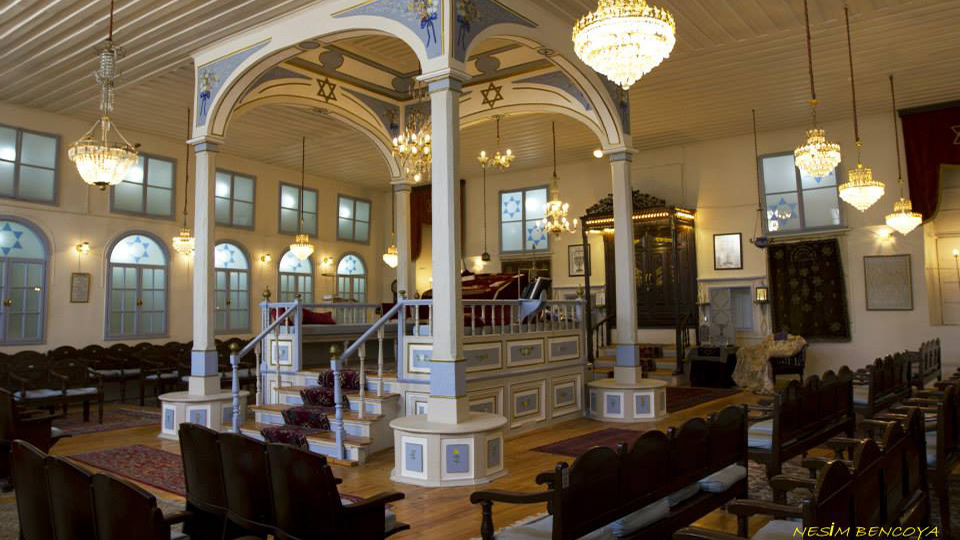
As it will be understood from the inscription at the gate of the Algazi Synagogue, which is also called Kal de Arriva (upper synagogue), it is agreed to have been erected in 1724 by Isaac Algazi of the Algazi Family that brought up prominent rabbis. Another view claims that this synagogue had existed long ago and controlled by Sabbatai Sevi in 1666. The inscriptions in the courtyard and gate which date back to 5649 (1889) and 5661 (1901) respectively remind of the dates of a reconstruction or any other significant repair of the synagogue after the great fire of 1841.
As in most of the Izmir synagogues, a cabinet on either side of the central Ehal constitutes a triple bloc. Tevah is in the centre of the main place of worship. On the right hand side of Ehal is the seat of the famous Chief Rabbi of Izmir, Abraham Palachi.
In the unroofed courtyard of the synagogue is seen a door which opens to the lower storey. The said lower storey was used as a Midrash in the past and was a place where ten old men (asara batlanim) prayed for the salvation of the country and the community all day long. Also, any unused holy books and objects were stored there before they were buried. This place is called Kal de Abasho (lower synagogue).
It is rumoured that, in this place of worship which had been considered to be one of the most important synagogues of Izmir by the early 20th century, it was decided to demolish the Azara (women’s loge) because a young Hazzan was detected to wink at a seated lady on Yom Kippur (Atonement Day) and it has been never built again.
Another person whose name is associated with the Algazi Family and with this synagogue is Isaac Ben Salomon Algazi. Born in 1889, Isaac Algazi was educated at Yeshiva Bet Hillel (religious school) of Hayim Palachi, famous rabbi of Izmir, and was a Hazzan at the Algazi Synagogue like his ancestors and perhaps became the greatest Sephardic composer of the first half of the twentieth century. In fact, Algazi Efendi gained the admiration of not only the Jews but the Turks as well and was ranked as an artist who was renowned by all the music circles. Due to his knowledge and mastery in music, he was called “Hodja” by the Turks. The synagogue is near the Havra (Synagogue) Street at Kemeralti.
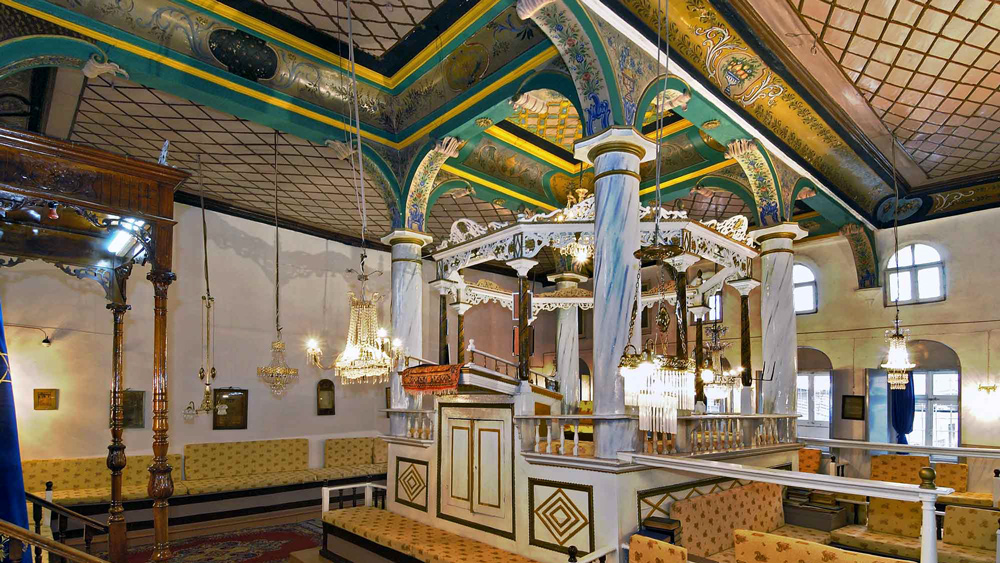
A Jew from Izmir called Salomon de Ciaves, a Dutch immigrant of Portuguese origin, donated one of the houses with a large courtyard on the Ikicesmelik Street to be used as a synagogue and ensured the purchase of all the books and sacred objects required for a synagogue and devoted some houses and shops adjacent to it to bring some revenues to the synagogue in 1724.
Also known as Ciaves Synagogue, it started to be called as Bikur Holim Synagogue meaning “visiting the sick” as from that date as the basement of the synagogue was used as a hospital during one of the plague or cholera epidemics frequently seen in the city. It is also possible that the said basement was once the Bet Din prison. Burnt in 1772, the synagogue was rebuilt in 1800 by Manuel de Ciaves of the same family.
With a central Tevah, ceiling decorated with flower and fruit pictures, embellished columns painted in green and yellow, this synagogue is one of the most beautiful places of worship in Izmir. It is situated in the Ikicesmelik Street. (Güleryüz, Trakya ve Anadolu Sinagogları, 2008,68)
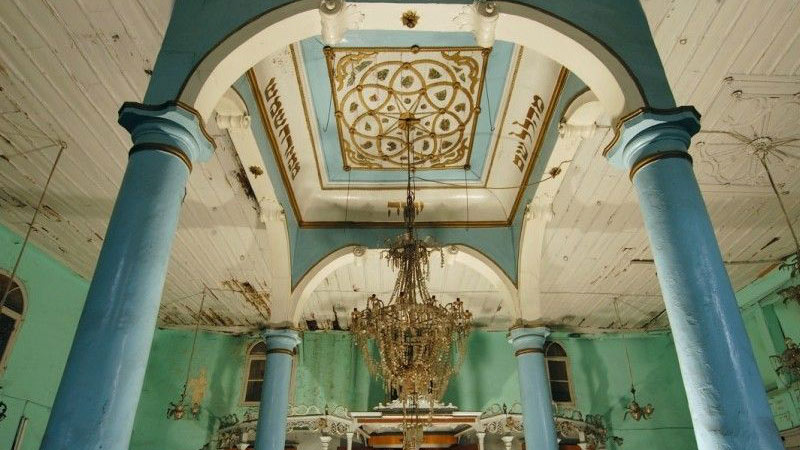
Etz Hayim Synagogue dates back to the Byzantine period like all the other synagogues bearing the same name. A document which belongs to Salomon Ben Ezra, who died in 1688, and which was cited in a book entitled Bate Knesiot, reads that the Moslem Turks also prayed in the only synagogue in Izmir. The period which this document mentions probably coincides with the period of Izmir’s conquest by the Turks, and it is understood that they prayed in this synagogue because there was no mosque in the city.
Having escaped dangers of fire and earthquakes time and again, this synagogue was damaged by the fire of 1841, and Daniel de Sidi had it repaired in 1851.
Etz Hayim Synagogue was built in a central plan in which its Tevah is situated in between four columns which divide its ceiling into nine rectangular parts and in which the sitting rows encircle this alignment. Tevah of this synagogue which is a conventional Izmir synagogue with its four columns supporting the roof, inter-columnar links inscribed with lines in Hebrew from the Old Testament and its triple Ehal composition with a cabinet on either side was constructed inspired by the European synagogue architecture and was moved from the centre where it must be situated to the side of Ehal during the repair in 1851.
Despite its floor which requires repairing, the synagogue is still standing with its azara and midrash. The synagogue has been recently repaired and restored with the support of İZKA and the İzmir Jewish Community Foundation.
Etz Hayim Synagogue is near the Havra (Synagogue) Street at Kemeralti.
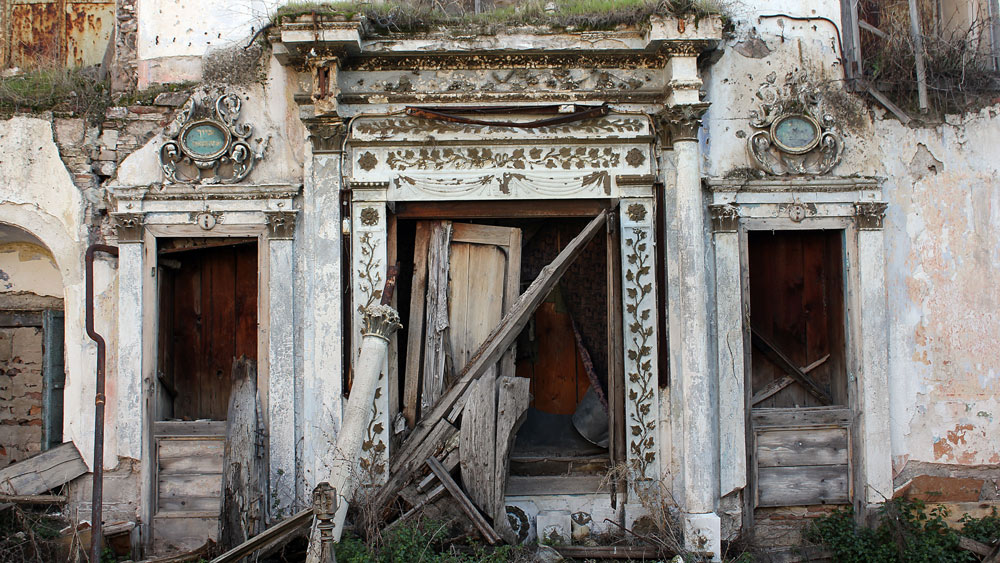 Hevra Sinagogue’s name as mentioned in very old texts is Talmud Torah Synagogue. Known to have existed in the time of Joseph Escapa in the 17th century, this synagogue was burnt and destroyed and rebuilt several times. Although it was rebuilt after the fire in September 1838 by Chelebi and Menahem Hacez brothers, it was burnt again in the fire of 1841 and remained in a ruined state for many years until it was repaired again. (Güleryüz, Trakya ve Anadolu Sinagogları,2008,68)
Hevra Sinagogue’s name as mentioned in very old texts is Talmud Torah Synagogue. Known to have existed in the time of Joseph Escapa in the 17th century, this synagogue was burnt and destroyed and rebuilt several times. Although it was rebuilt after the fire in September 1838 by Chelebi and Menahem Hacez brothers, it was burnt again in the fire of 1841 and remained in a ruined state for many years until it was repaired again. (Güleryüz, Trakya ve Anadolu Sinagogları,2008,68)
Built in the central plan, the Hevra Synagogue is a typical Izmir synagogue with its Tevah, triple Ehal composition and Midrash. As in Shalom Synagogue, the Tevah here was also made in the form of the prow of a galley inspired by the Ottoman galleys which brought the Jews from Spain. The huge number of the Sefer Torah (Old Testament) available in Hevra Synagogue ensured it to occupy so prestigious a status.
The roof of the synagogue had collapsed in 1999, and rescue efforts were carried out in 2020 with the contributions of the German Ministry of Foreign Affairs.
The synagogue is located near the Havra (Synagogue) Street at Kemeralti.
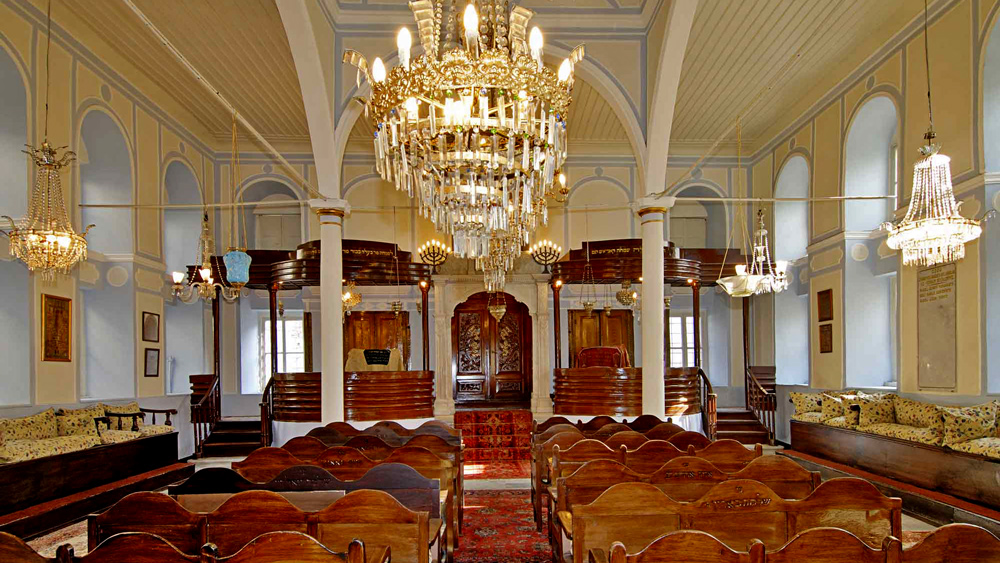
Historian Galante acknowledges that it is probable that this synagogue was erected by a Jewish lady of Dutch origin called either Osbio or Aseo, who also founded the Lazaretto poors’ home. According to the popular belief, it was built with the donations from a lady by the name of Donna Gracia Nasi renowned by the nickname of Gveret or La Signora, who was the aunt of Joseph Nasi, who was promoted to an important rank at the Ottoman palace. Considering that the only woman who was known by the name of Signora at this time was Donna Gracia and that there is also a synagogue which goes by the same name in Istanbul, the validity of this view enhances. Burnt several times in the 16th and 17th Centuries, the building was completely destroyed in the fire of 1841 and rebuilt with the contributions from Moiz Bengiat Yerushalmi.
The synagogue is accessible with a staircase with five steps. From the order of the floor of the synagogue, it is understood that Tevah which had been earlier situated between four columns in the centre was moved to the side of Ehal, and a shift was made to the practice of a double Tevah on the left and right in 1940. With its door bearing lines from the Old Testament, Ehal is in compliance with the triple order which is specific to Izmir. The lower part of the Azara balcony is decorated with original flower and landscape pictures specific to this synagogue. The synagogue is located near the Havra (Synagogue) Street at Kemeralti.(Güleryüz, Trakya ve Anadolu Sinagogları, 2008,68)
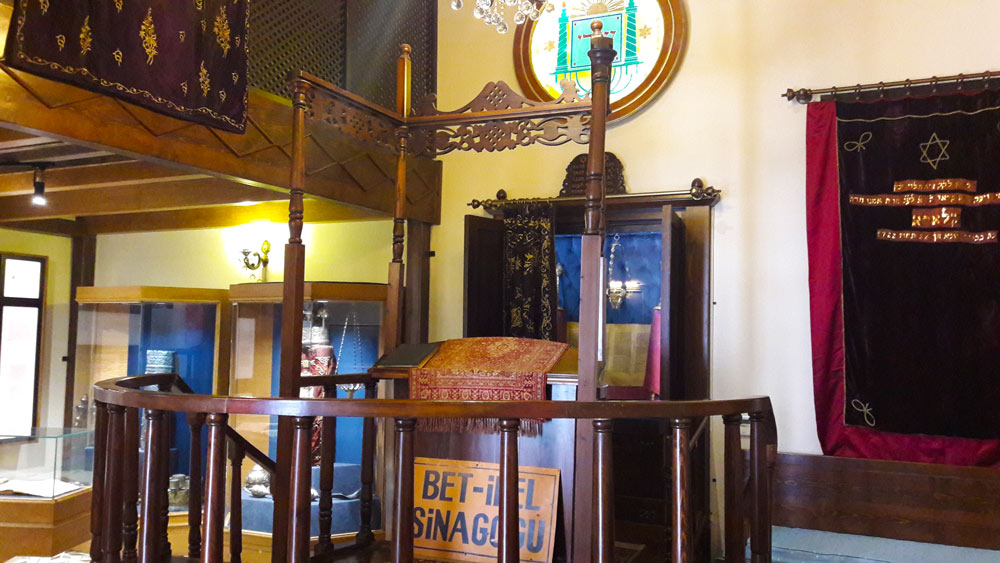
Beit Hillel Synagogue was established in the house of the Palachi family. Rabbi Hayim Palachi (1788-1869) and his son Rabbi Abraham Palachi (1809-1899) are the most prominent theologians of the Jewish community of Izmir in the 19th century. Both are referred to as the greatest men of the period, and their renown went beyond the limits of Izmir and the borders of Turkey, causing the Jewish theologians of Europe and Middle East to come to Izmir for consultation. Rabbi Hayim Palachi wrote a total of 72 books all through his life, and of these, 26 books were published. He was awarded the “Theologian responsible for justice” in 1861 by the Sultan Abdulmecid.
Born in Izmir in 1788, Hayim Palachi, who attended the Jewish School and became theologian at the age of 25. He was nominated a religious judge at the age of 40 and promoted as the Chief Rabbi in 1875 when he was 77 years old. He wrote books which are still studied as textbooks at theological schools all over the world.
Beit Hillel Synagogue is believed to be among the holy places by Hayim Palachi’s students along with the tomb of Rabbi Hayim Palachi and the purification pool (Mikve) in the Gurcesme cemetery which is called the diamond triangle and must be absolutely visited.
The Municipality of Izmir has restored the building which serves as a memorial for Rabbi Palacci. It is located near the Havra (Synagogue) Street at Kemeralti.
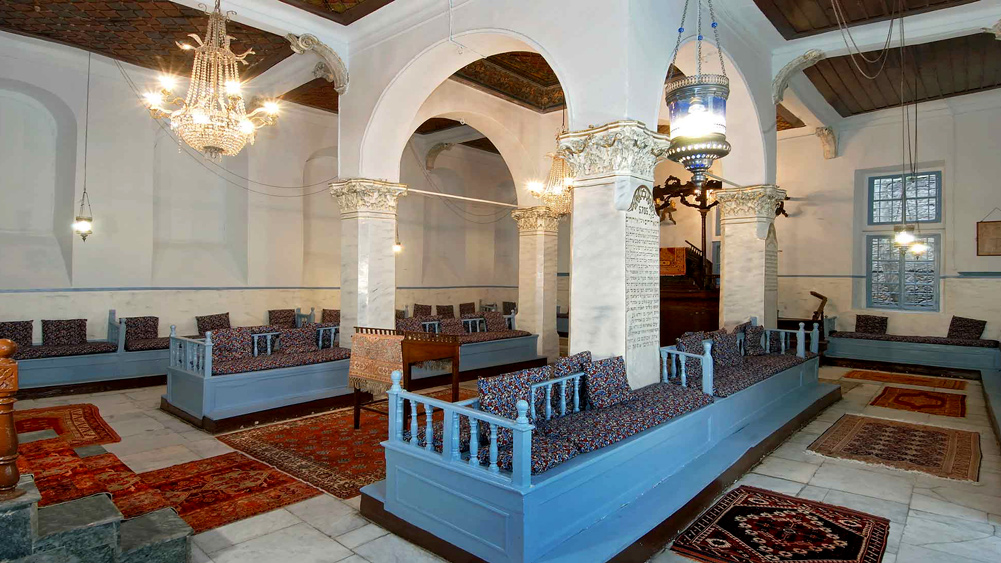
Shalom Synagogue is also known by the name of “El Kal de la Tromba” which means Synagogue of the Water Pump and started to be called Aydinlilar Synagogue in the 1930s when it was allocated to the Jews who came from Aydin. It is a synagogue in which Joseph Escapa, who became the religious leader of the Jewish Community of Izmir in 1648 and achieved their very first organisation, acted as the Chief Rabbi as from 1620. Rabbi Joseph Escapa also provided young Sabbati Sevi with religious education, but once Sabbatai Sevi had declared himself Messiah, he got the ball running in the latter’s dismissal from Izmir. Shalom Synagogue is the only synagogue which was not destroyed by the fire of 1841.
The interior of the Shalom Synagogue, which may be said to be the most authentic synagogue of Izmir, is reminiscent of a typical Turkish house with its ceiling decorated with engravings, sofas along the walls and floral cushions and pillows. Tevah of the synagogue inspired by the Ottoman galleys which brought the Jews from Spain in the 15th century, really resembles the prow of a galley.
Although it was built in the central style, Tevah was removed from the centre in 1939 and placed before the wall across the Ehal. The conventional triple Ehal composition also exists in this synagogue.
While Palestine was part of the Ottoman Empire in the 16th century, the Sephardic Jews, who first settled there, acknowledged the city of Safed as a religious centre and the holy city of Kabbalah and built synagogues called the Blue Synagogues. The blue colour of the Shalom Synagogue is relevant due to its association with the Safed synagogues.
There is an iron Sukkah with a crown symbolising the Kingdom of the Lord on it in the courtyard of the synagogue. It is claimed to be the only sukkah with a crown in the world. The synagogue is near the Havra (Synagogue) Street at Kemeralti.
The only synagogue in Izmir whose name identifies from what country its founders immigrated is the Portuguese Synagogue. It is presumed that this synagogue was founded by the Jews of Portuguese origin who immigrated from North Africa and Venice in 1569. It is one of the six synagogues known to have existed in the period of Chief Rabbi Joseph Escapa, i.e. in the 1620s, and is referred to as the largest synagogue in Izmir in that period.
Portuguese Synagogue had a significant role in the events experienced upon Sabbatai Sevi’s return to Izmir in 1665. Considered to be the fortress of the anti-Sabbatai-ists, this synagogue closed its gates to Sabbatai Sevi when the Sabbatiai-ist movement expanded.
On the other hand, Sabbatai and his supporters enter the synagogue by breaking the Gates and chase away the rabbis who are the leaders of their opponents. Salomon Algazi, who is one of the founders of Algazi Synagogue, is among them. Sabbatai Sevi declares himself the Messiah of the Jews and 18th June 1666 the deliverance day in that raid. Portuguese Synagogue becomes the headquarters of the Sabbatai-ist movement and a large group of the Jews of Izmir join in the movement. The fact is reported to the Sultan when people come from different parts of the world to Izmir and join in the Sabbatai-ist movement and the atmosphere of revolt in Izmir is broken up once Sabbatai is called to the palace.
Portuguese Synagogue was burnt in 1976 and is in a completely ruined state except its front wall. The synagogue building serves today as EGIAD Social and Cultural Center. It is located near the Havra (Synagogue) Street.
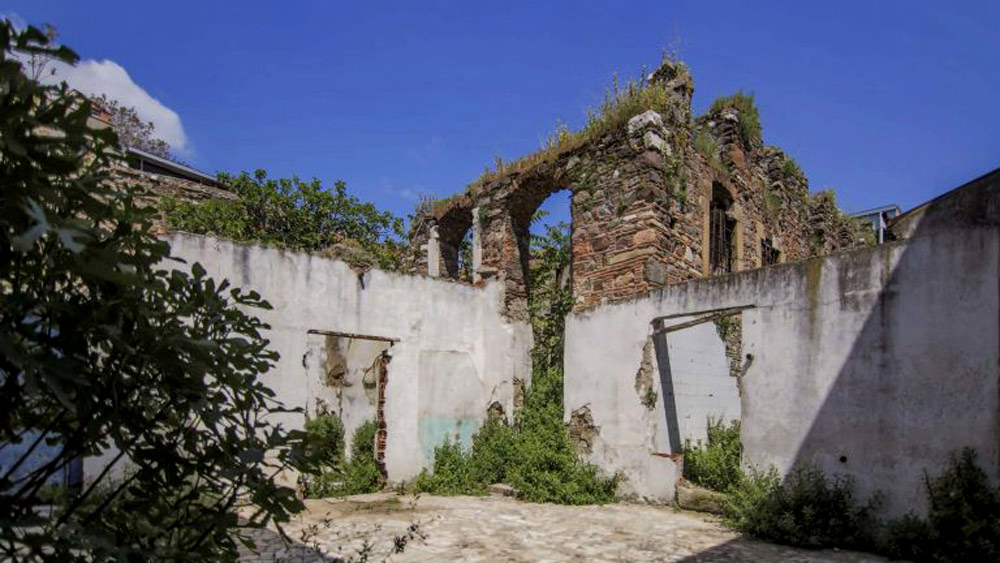
Los Foresteros Synagogue is one of four adjacent synagogues, a unique, none of a kind in the world. The name means ‘strangers’. It is estimated that it was founded by foreigners who immigrated to İzmir from the Aegean Islands, Greece and various European countries. It was probably built in the 17th century and remained active until it was destroyed by fire. After demolition it was used for kosher poultry slaughter. Its restoration has started in 2022
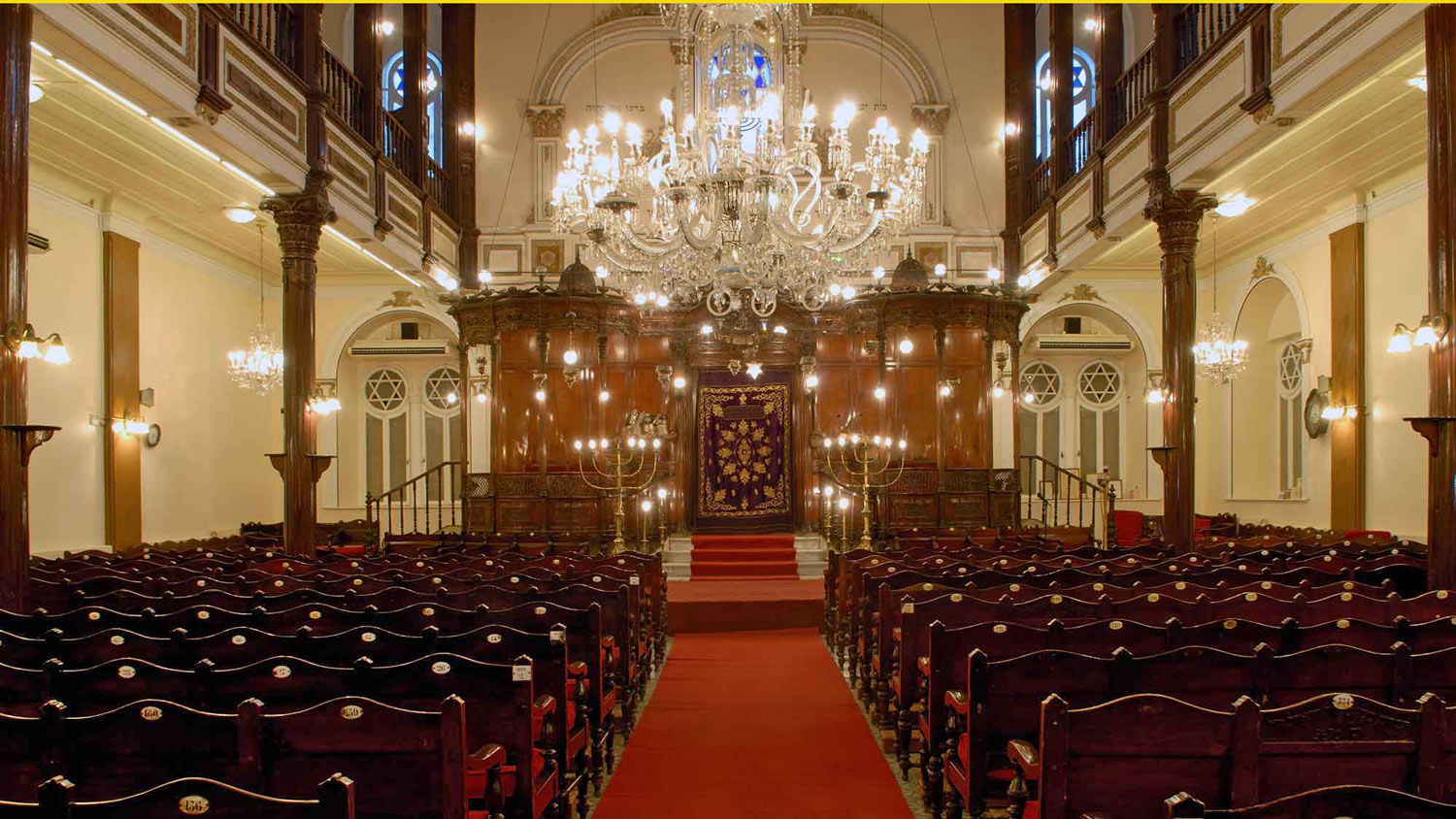
The Jewish bourgeoisie which started to develop in the middle of the 19th century left the traditional Jewish quarters and found a new residential area. This area was the southern coast and hills of the gulf which is now the Mithatpasa Street. When the need for prayer of the Jewish population which gradually increased in this area could not be satisfied by the existing synagogues, an application was filed with Sultan Abdulhamid II in order to build a new and larger synagogue.
Upon the Sultan’s edict, the construction Bet Israel Synagogue started on 15th March 1905 and it was opened to prayer in 1907. However, economic distress delayed the completion of its internal decoration and the synagogue took its present state in 1950.
Bet Israel is the largest and most magnificent synagogue of Izmir and religious marriage ceremonies usually take place here. The building style and sitting order of the synagogue are different from the conventional Izmir style and it was not constructed with a central plan. There has been a double Tevah application from the beginning. Due to the position of the building plot, Ehal Ekodesh has been placed in the southern wall but not in the eastern wall. Therefore, prayer is said turning toward the eastern wall. It was thought to cover the synagogue with a large dome, but due to economic distress, it has been covered by a small dome.
The woodwork of Bet Israel Synagogue was performed by the use of massive mahogany by the Italian master workers and is reminiscent of Italian synagogues. Bet Israel Synagogue is two-storied. While the downstairs is reserved for the men, the upstairs has been built as the women’s section. At present, the upstairs houses a small exhibition hall consisting of religious objects, documents and photographs. The synagogue is located in the Mithatpasa Street at Karatas.
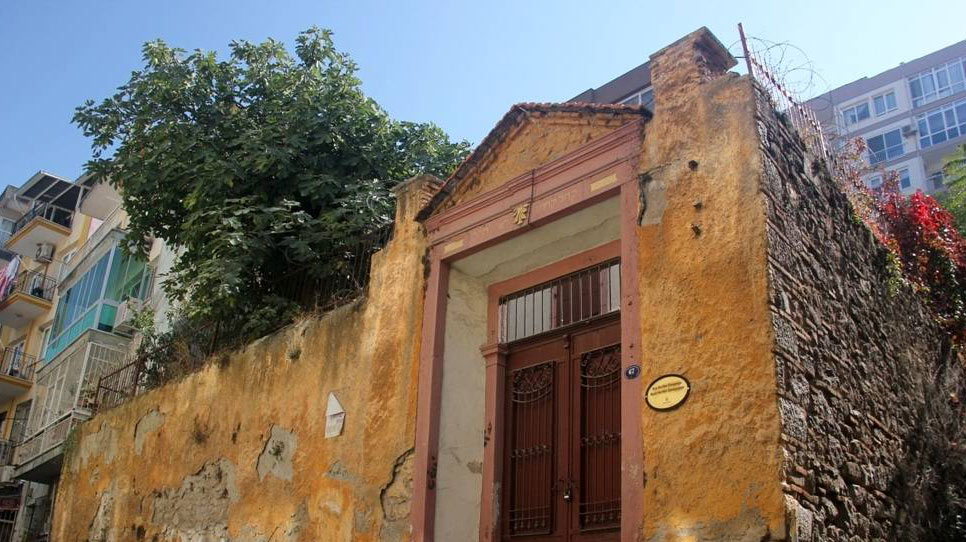
The Jews, who deserted their traditional district as from the second half of the 19th century, started to settle at Karatas and its vicinity. While wealthy preferred the seaside, families with a lower income got a foothold at the Halil Rifat Pasa district. Lack of a synagogue which did not satisfy the ever-growing Jewish community’s need of prayer in this district earlier prompted the inhabitants living there to erect a new synagogue.
Although not known for sure, the date 1894 in an inscription donated to the synagogue by Moshe Levi, son of Nesim Levi Bayrakli, and two holy book covers bearing the dates 1896 and 1904 suggest that the synagogue was built in the 1890s.
Rosh Ha Har Synagogue was built in the central planned architecture and Ehal has a triple composition as in the other synagogues in Izmir. Although this synagogue regularly hosted prayers and ceremonies by the 1960s, it has started to be used only in the occasion of holidays due to the decrease in the Jewish population. The synagogue is located in the Halil Rifat Pasa Street.
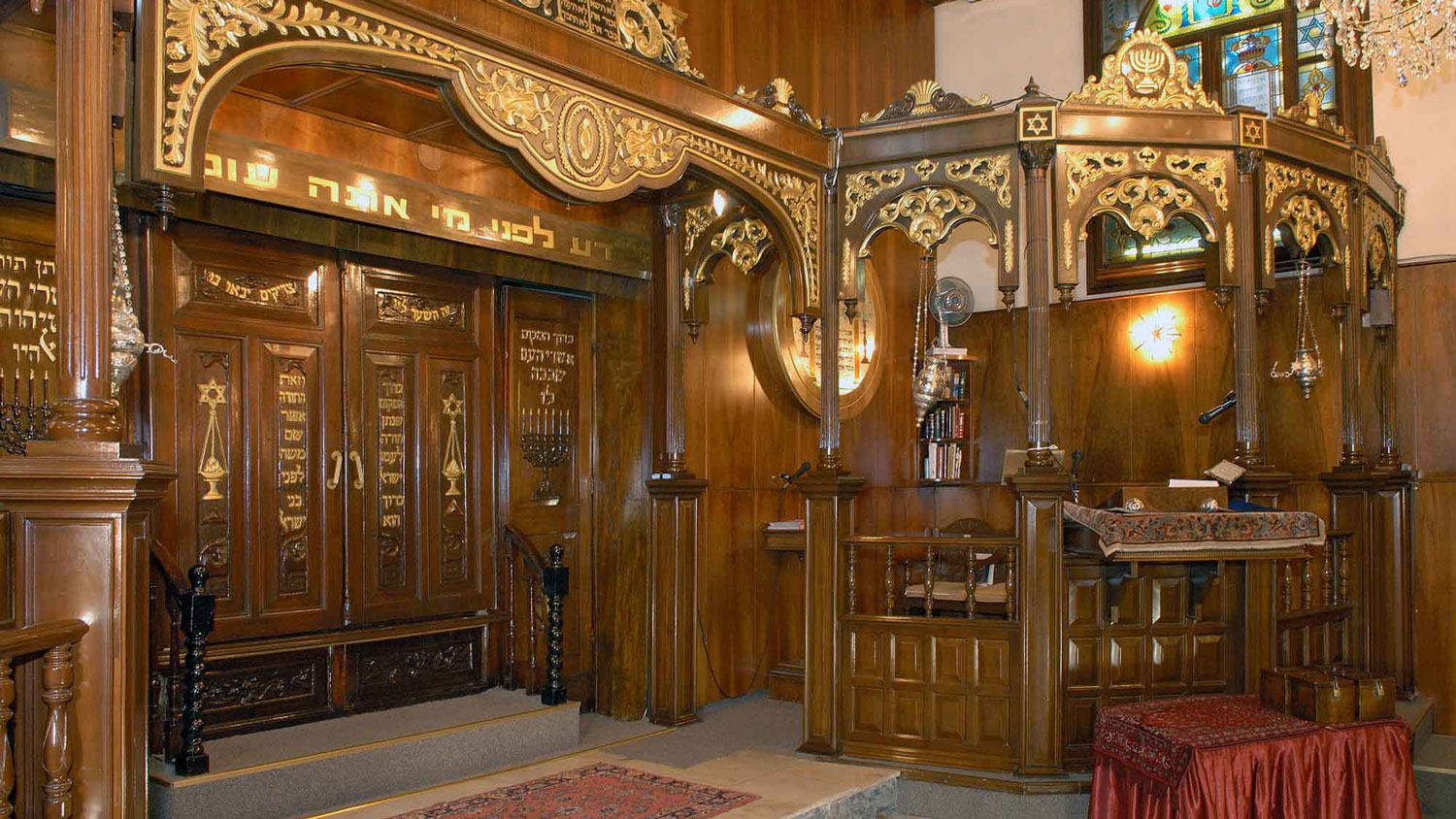
Shaar Asamayim was built for the Jews settled at Alsancak. It has been re built in the recent years and opened at December 1 st, 2019. Saar Asamayim is the mostly used Synagogue in Izmir after Bet Israel.
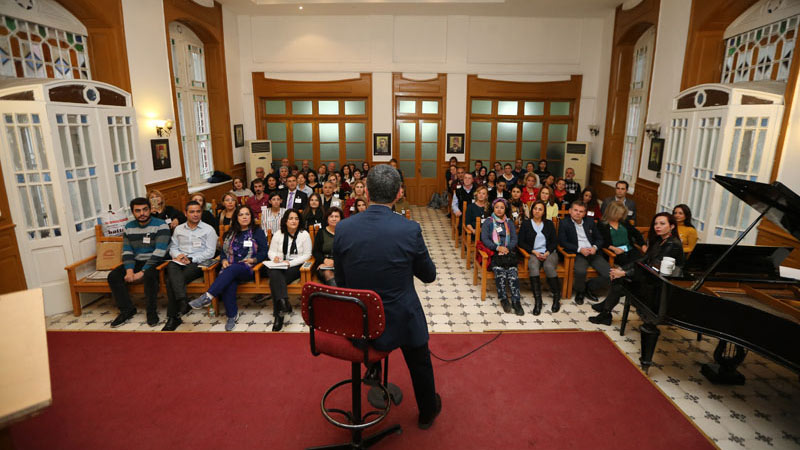
Synagogue Mezake et Harabim Synagogue was founded in 1881-1882 and built after Jews moved to the Karsiyaka (Kordelyo) area from the traditional Jewish quarters. The synagogue building has undergone a successful renovation and conservation at the hands of the Karsiyaka Municipality, after the community agreed to transfer it to the City for public use. The holy Ark and the Hebrew verses on the walls were restored and preserved, and today the building serves as the music center of the city. the hands of the Municipality, after the community agreed to transfer it to the City for public use.